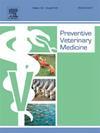预测模型,以确定最佳策略的过敏反应应用在牛到达饲养场
IF 2.2
2区 农林科学
Q1 VETERINARY SCIENCES
引用次数: 0
摘要
过敏反应是指在到达饲养场时对一群牛使用一种抗菌剂,是对某些牛种群控制牛呼吸道疾病(BRD)的一项重要策略。预测建模技术可用于根据预期的经济结果而不是主观地帮助确定哪些队列应该接受过敏反应。研究目的是评估用牛人口统计学变量训练的预测模型,以确定哪些队列应该根据最高净回报的经济评估接受过敏反应,并阐明添加原始和外部经济变量对模型性能的好处。利用16368头牛的数据,建立了四种预测模型:增强决策树、逻辑回归、神经网络和随机森林。采用受试者工作特征曲线下面积(AUC-ROC)评价模型的性能。使用相同的算法来比较将原始和外部经济数据添加到基线模型中。总体而言,模型性能较高,基线模型的AUC-ROC值在0.80至0.93之间。加入商品期货价格等外部经济变量会提高业绩(AUC-ROC= 0.92-0.94)。添加原始数据,如城市和州,导致性能较差(AUC-ROC= 0.79-0.89)。外部经济数据与原产地的结合导致AUC-ROC值居中(AUC-ROC= 0.87-0.91)。该研究表明,预测模型可以成功地用于选择最佳的过敏反应策略,并通过经济评估确定牛到达饲养场。本文章由计算机程序翻译,如有差异,请以英文原文为准。
Predictive models to determine best strategy for metaphylaxis application in cattle at arrival to a feedyard
Metaphylaxis, the application of an antimicrobial to a cohort of cattle at arrival to a feedyard, is an important bovine respiratory disease (BRD) control strategy for certain cattle populations. Predictive modeling techniques could be used to assist in determining which cohorts should receive metaphylaxis based on a desired economic outcome instead of subjectively. The study objective was to evaluate predictive models trained with cattle demographic variables to determine which cohorts should receive metaphylaxis based on an economic evaluation of highest net returns and to elucidate the benefit to model performance with the addition of origin and external economic variables. Data from 16,368 cattle cohorts were used to build four predictive models: boosted decision tree, logistic regression, neural network, and random forest. Area under the Receiver Operating Characteristics curve (AUC-ROC) was used to evaluate model performance. The same algorithms were used to compare adding origin and external economic data to the baseline models. Overall, model performance was high with AUC-ROC values ranging from 0.80 to 0.93 in the baseline models. Adding external economic variables such as commodity futures prices increased performance (AUC-ROC=0.92–0.94). Adding origin data, such as city and state, resulted in poorer performance (AUC-ROC=0.79–0.89). The combination of external economic data and origin resulted in intermediate AUC-ROC values (AUC-ROC=0.87–0.91). The study demonstrated that predictive models can be used successfully to select an optimal metaphylaxis strategy as determined by economic evaluation for cattle arriving at the feedyard.
求助全文
通过发布文献求助,成功后即可免费获取论文全文。
去求助
来源期刊

Preventive veterinary medicine
农林科学-兽医学
CiteScore
5.60
自引率
7.70%
发文量
184
审稿时长
3 months
期刊介绍:
Preventive Veterinary Medicine is one of the leading international resources for scientific reports on animal health programs and preventive veterinary medicine. The journal follows the guidelines for standardizing and strengthening the reporting of biomedical research which are available from the CONSORT, MOOSE, PRISMA, REFLECT, STARD, and STROBE statements. The journal focuses on:
Epidemiology of health events relevant to domestic and wild animals;
Economic impacts of epidemic and endemic animal and zoonotic diseases;
Latest methods and approaches in veterinary epidemiology;
Disease and infection control or eradication measures;
The "One Health" concept and the relationships between veterinary medicine, human health, animal-production systems, and the environment;
Development of new techniques in surveillance systems and diagnosis;
Evaluation and control of diseases in animal populations.
 求助内容:
求助内容: 应助结果提醒方式:
应助结果提醒方式:


